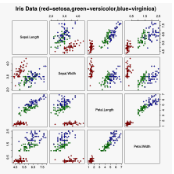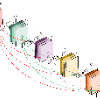Iris recognition systems transform an iris image into a feature vector. The seminal pipeline segments an image into iris and non-iris pixels, normalizes this region into a fixed-dimension rectangle, and extracts features which are stored and called a template (Daugman, 2009). This template is stored on a system. A future reading of an iris can be transformed and compared against template vectors to determine or verify the identity of an individual. As templates are often stored together, they are a valuable target to an attacker. We show how to invert templates across a variety of iris recognition systems. That is, we show how to transform templates into realistic looking iris images that are also deemed as the same iris by the corresponding recognition system. Our inversion is based on a convolutional neural network architecture we call RESIST (REconStructing IriSes from Templates). We apply RESIST to a traditional Gabor filter pipeline, to a DenseNet (Huang et al., CVPR 2017) feature extractor, and to a DenseNet architecture that works without normalization. Both DenseNet feature extractors are based on the recent ThirdEye recognition system (Ahmad and Fuller, BTAS 2019). When training and testing using the ND-0405 dataset, reconstructed images demonstrate a rank-1 accuracy of 100%, 76%, and 96% respectively for the three pipelines. The core of our approach is similar to an autoencoder. However, standalone training the core produced low accuracy. The final architecture integrates into an generative adversarial network (Goodfellow et al., NeurIPS, 2014) producing higher accuracy.
翻译:Iris 识别系统将 iris 图像转换成特性矢量 。 原始管道部分将图像转换成 iris 和非 iris 像素, 将这个区域正常化成一个固定的 Dimension 矩形, 并提取存储和称为模板的功能( Daugman, 2009) 。 此模板存储在一个系统中。 未来对 iris 的读数可以转换, 与模板矢量进行对比, 以确定或验证个人的身份 。 由于模板通常被一起存储, 它们是攻击者的宝贵目标 。 我们展示了如何在各种 iris 更高识别系统中将模板反转成真实的 iris 矩形 。 也就是说, 我们展示了将模板转换成真实的 iris 图像, 并被相应的识别系统也被视为真实的 。 我们的 将 IRIS- 1 用于确定或验证个人的身份 。 我们将 RESIST 应用于传统的 Gabor 过滤管道, 它们是攻击者的宝贵目标 。 (Huang et al. CVPR 2017) 地标选取器, 地标选取, 3 Net 的精选取, 网络 正在运行运行一个不使用一个常规的 Ral- breal- brealal- dealationalalalalalalalalmailveal





